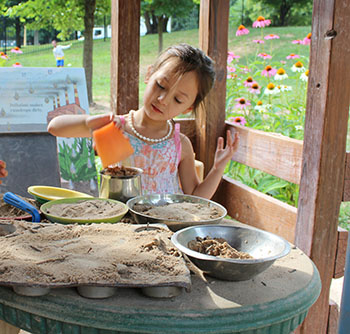Week 5

Mud!
Making mud pies has to be the quintessential activity for every kid. The Green Room class set up a mud kitchen for just this purpose. Using an old sensory table filled with mud, some clay in a bucket, a pail of sawdust, sticks, stones, and some artificial flowers children baked all sorts of lovely mud recipes. Some of the recipes were written down and illustrated for those interested. Here's one: (coming soon)
As a follow up activity children made "dirt cups" for afternoon snack by mixing chocolate pudding topped with crushed Oreo and a gummy worms.
Dr. Daniels Returns
This time Dr. Daniels, our scientist grandfather, had the children mix two liquids, water and oil, to see that they really did not mix well at all, not even when the campers shook them up. Next the children were instructed to add dish soap to the mix and found it broke the oil up into small pieces and formed bubbles at the top of the mixture. Later using old water bottles the children recreated this activity adding glitter and sequins to float around in the oil and water. It was fun to shake up the mixture and watch the action.
Mixing Ideas

CYC director Dr. Guha has done some collaboration with theCollege of Information Studies & Human-Computer interaction Lab, at the University of Maryland and was able to share some of her techniques to help the children mix ideas.
She used these methods to help the children come up with a culminating activity for the end of the summer mixing study. To begin with each child came up with their own idea. Taking these ideas, Dr. Guha paired similar ideas together and had those teams work together to combine the two similar ideas. The children used a clip board to draw what they were thinking and an adult helped write their words.
After analyzing these combined ideas Dr. Guha organized them into something that would work for a culmination. Many of the ideas included demonstrating or showing specific mixing activities to their families specifically, bubbles, gak, muffins, mud pies, and Dr. Daniels experiments. One team's party and games idea turned out to be the glue for these and it was decided that different stations would be set up in the room manned by the children who would demonstrate these activities at a mixing party for families.
A second meeting confirmed this mixing of ideas as the right way to go about the culmination and children signed up for specific activities to be in charge of.
Gazpacho

The book Gazpacho for Nacho by Tracey C. Kyle was the catalyst and excuse to take a field trip to the local farmers market to purchase the ingredients for the soup. The class, accompanied by several parents, trekked to the middle of campus where the Campus Farmers Market sets up every Wednesday. The children chose tomatoes, cucumbers, peppers, an onion, and some basil for the ingredients. In addition a box of very large black berries and a baguette were purchased to add to the snack..
The following day, children helped chop up the vegetables and mix them into a delicious and nutritious afternoon meal.
Tie Dye
Each summer, tie dye is a very popular activity and even a day is reserved for children to wear their hand made shirts. Tie dying is a natural for a mixing study since several colors are needed and spread and blend together to make new designs and colors. After watching a how-to video from youtube, campers twisted a spiral shape in their tee shirts, attached rubber-bands around the shape and chose four different colors to apply to their neat little package. The colors blended and mixed to form unique designs for each child. These shirts will be worn on the last day of camp which is designated as "tie dye" day.
